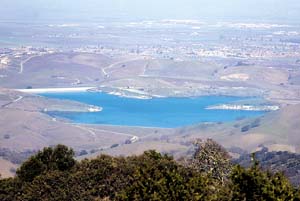State officials confirmed today the first known discovery in
California of zebra mussels
– an invasive shellfish that can clog water pumps and pipes and
could potentially wreck havoc on California’s water and power
system – in the San Justo Reservoir.
HOLLISTER
State officials confirmed today the first known discovery in California of zebra mussels – an invasive shellfish that can clog water pumps and pipes and could potentially wreck havoc on California’s water and power system – in the San Justo Reservoir.
The California Department of Fish and Game confirmed today it’s the first known presence of the species in state waters.
Aside from local impacts to the environment and recreational offerings, what makes it worrisome on a broader level is that the San Justo Reservoir is connected to the state’s Central Valley water system. San Benito County Water District Manager Lance Johnson said zebra mussels are highly mobile – they can spread through water currents – and have the potential to block water pipelines, pumps and valves.
“This has major implications to it,” Johnson said.
Zebra mussels are also extremely efficient filter feeders that can destroy the food base for indigenous water ecosystems. And a county supervisor today expressed concerns that the discovery could harm local farmers, too.
The U.S. Bureau of Reclamation, which owns San Justo Reservoir, suspects the zebra mussels found there are 1 to 3 years old, said Jeff McCracken, spokesman for the bureau office in Sacramento.
It means they likely have been there for a long time, he noted.
“So this isn’t like one just showed up,” he said.
Dr. B.J. Miller, a civil engineer who has worked with invasive species’ in the Sacramento-San Joaquin Delta for more than a decade, said today the farther away from the reservoir the zebra mussel was introduced, the larger the problem.
Miller said larvae are buoyant and can float, but most likely would not travel against the flow of water from the reservoir into the delta system.
“It will be interesting to find out how they think it got into this little reservoir,” Miller said.
Alexia Retallack, spokeswoman for the California Department of Fish and Game, said the zebra mussels found in San Justo Reservoir most likely were spread through recreational users.
Retallack said a fisherman pulled up a clump of the mussels Jan. 5 and took them to fish and game officials. The agency had the California Department of Food and Agriculture test the mollusks to determine they are the zebra mussel species, Retallack said.
The spokeswoman added that the California Department of Water Resources searched for the mussel in the Central Valley system and could not find any. Invasive quagga mussels – a relative of the zebra – have been found in Southern California, Retallack noted.
Bureau of reclamation officials first contacted Johnson on Wednesday about samples from the reservoir believed to be the invasive species, he said.
The discovery will affect recreational activities there, Johnson said, but it is too early to tell whether it has broader implications.
“There’s a lot more work that needs to be done,” Johnson said. “We don’t go hitting the panic button yet.”
The nickel-sized mussel can spread easily through larvae on the hulls of boats and in the cooling systems of motors. Adult mussels also can be carried on the shoes of recreation area users and spread that way.
Nationally, zebra mussels have caused billions of dollars in damage, according to the Virginia Department of Game and Inland Fisheries. Zebra mussels cost industries, businesses and communities more than $5 billion from 1993-1999, according to the department.
The state’s fish and game department on Thursday collected more samples, which were sent to Sacramento for testing.
San Benito County Supervisors Anthony Botelho, Don Marcus and Reb Monaco all confirmed today they had been notified about the discovery and said they were waiting to hear more.
“I just have my fingers crossed that this zebra mussel came from another area,” Botelho said. “Nobody has said, once it’s there, what you do about it.”
Anything that threatens water from the reservoir could deal a blow to local agriculture, he said.
“I’m very concerned about irrigation water,” Botelho said. “This is really, really bad news – it could be the straw that broke the camel’s back for farmers (who are already facing a water shortage).”
San Benito County runs the concession stand at San Justo Reservoir and shut down the recreation area on Friday, County Administrative Officer Susan Thompson said.
The county is just following directions from the fish and game department and water district, Thompson said. But she added: “It’s concerning, obviously. Otherwise we wouldn’t have closed it down.”
Johnson said a conference had been scheduled for today with the bureau of reclamation, the department of fish and game, the county’s water district and other government agencies.
“We don’t know yet where they came from, how they got here,” Johnson said.
Officials did not know when the reservoir would re-open.
Free Lance Editor Kollin Kosmicki contributed to this report.









